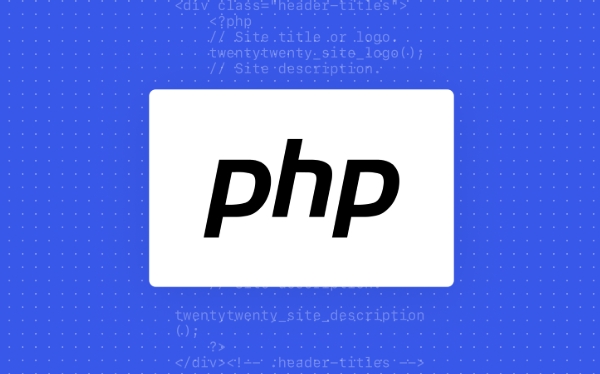PHP session not working on mobile or in some browsers
Jul 11, 2025 am 12:20 AMPHP session fails on mobile phones or some browsers, mainly due to cookie settings, session ID delivery or cross-domain issues. 1. The Session ID is not saved or passed correctly. If the third-party cookies are disabled, the user disables the cookies or misses the sid, make sure to call session_start() and check the cookie settings. 2. Mobile browser policies are strict. For example, iOS Safari blocks third-party cookies in iframes. Iframes should avoid nesting key processes and unifying domain names. 3. The Session file is not read and written correctly. If the permissions are insufficient or the multiple servers are not synchronized, you need to check the log and debug output to confirm consistency. 4. HTTPS and cookie security settings are inconsistent. If the secure flag is not turned on, secure, httponly and other parameters should be configured in php.ini or code to ensure transmission security.

You may have encountered this situation: PHP session works properly on a computer browser, but it fails on a mobile phone or some browsers. This is actually a relatively common problem, and the main reasons may involve cookie settings, session ID delivery methods, or cross-domain issues. Let me talk about several common situations and solutions.

1. Session ID is not saved or passed correctly
This is one of the most common reasons. session Relies on the client's session ID (usually stored via cookies). If this ID is not properly saved or returned to the server, the same session cannot be continued.
Possible problems:

- Mobile browsers do not accept third-party cookies by default or automatically clear cookies in privacy mode.
- The user has disabled cookies.
- Session_id is missed during the page jump (for example, pass sid with GET but missed).
Suggested practices:
- Make sure to call
session_start()at the beginning of all pages. - Don't pass PHPSESSID manually through the URL unless you are very clear about what you are doing.
- Use the developer tool to check if the cookie is actually set and if it is carried in subsequent requests.
2. The cookie policy on mobile devices is stricter
Many mobile browsers (especially Safari on iOS) handle cookies more conservatively than desktop browsers. for example:

- If your website is embedded via iframe, Safari will block third-party cookies by default.
- Browsers with higher privacy settings will limit the life cycle of cookies or directly refuse storage.
Coping method:
- Try to avoid iframe nested login or session processes.
- Make sure the domain name is consistent and do not switch http/https or www/non-www frequently.
- You can try to pop up a prompt when the user first visits, guiding them to refresh the page or allow cookies.
3. Session file is not written or read correctly
Sometimes session does not take effect at all, but because of configuration issues, session data is not saved or read correctly.
Common reasons:
- The server's session.save_path permission is insufficient, resulting in session writing failure.
- The session storage paths are out of sync between multiple servers (if you use load balancing).
- session_name() is not unified after being modified.
Troubleshooting suggestions:
Check the server log for session-related errors.
-
Add simple debug output to the code, for example:
session_start(); var_dump($_SESSION); var_dump(session_id());
Confirm that session_name() is consistent everywhere and has not been changed unexpectedly.
4. HTTPS and cookie security settings are inconsistent
If your site has HTTPS enabled but the Secure logo of the session cookie is not enabled, some browsers may ignore the cookie, especially on mobile devices.
Solution:
Set in php.ini:
session.cookie_secure = 1 session.cookie_httponly = 1 session.use_only_cookies = 1
Or set it dynamically in the code:
session_set_cookie_params([ 'lifetime' => 0, 'path' => '/', 'domain' => '.yourdomain.com', 'secure' => true, // Send 'httponly' => true, 'samesite' => 'Lax' ]); session_start();
Basically these common reasons. When the session does not work on some browsers or devices, priority is given to check whether the cookie is set normally, whether the session ID is continuously passed, and whether the HTTPS settings match. These problems may seem small, but can easily affect the overall experience.
The above is the detailed content of PHP session not working on mobile or in some browsers. For more information, please follow other related articles on the PHP Chinese website!

Hot AI Tools

Undress AI Tool
Undress images for free

Undresser.AI Undress
AI-powered app for creating realistic nude photos

AI Clothes Remover
Online AI tool for removing clothes from photos.

Clothoff.io
AI clothes remover

Video Face Swap
Swap faces in any video effortlessly with our completely free AI face swap tool!

Hot Article

Hot Tools

Notepad++7.3.1
Easy-to-use and free code editor

SublimeText3 Chinese version
Chinese version, very easy to use

Zend Studio 13.0.1
Powerful PHP integrated development environment

Dreamweaver CS6
Visual web development tools

SublimeText3 Mac version
God-level code editing software (SublimeText3)

Hot Topics
 Why We Comment: A PHP Guide
Jul 15, 2025 am 02:48 AM
Why We Comment: A PHP Guide
Jul 15, 2025 am 02:48 AM
PHPhasthreecommentstyles://,#forsingle-lineand/.../formulti-line.Usecommentstoexplainwhycodeexists,notwhatitdoes.MarkTODO/FIXMEitemsanddisablecodetemporarilyduringdebugging.Avoidover-commentingsimplelogic.Writeconcise,grammaticallycorrectcommentsandu
 How to Install PHP on Windows
Jul 15, 2025 am 02:46 AM
How to Install PHP on Windows
Jul 15, 2025 am 02:46 AM
The key steps to install PHP on Windows include: 1. Download the appropriate PHP version and decompress it. It is recommended to use ThreadSafe version with Apache or NonThreadSafe version with Nginx; 2. Configure the php.ini file and rename php.ini-development or php.ini-production to php.ini; 3. Add the PHP path to the system environment variable Path for command line use; 4. Test whether PHP is installed successfully, execute php-v through the command line and run the built-in server to test the parsing capabilities; 5. If you use Apache, you need to configure P in httpd.conf
 PHP Syntax: The Basics
Jul 15, 2025 am 02:46 AM
PHP Syntax: The Basics
Jul 15, 2025 am 02:46 AM
The basic syntax of PHP includes four key points: 1. The PHP tag must be ended, and the use of complete tags is recommended; 2. Echo and print are commonly used for output content, among which echo supports multiple parameters and is more efficient; 3. The annotation methods include //, # and //, to improve code readability; 4. Each statement must end with a semicolon, and spaces and line breaks do not affect execution but affect readability. Mastering these basic rules can help write clear and stable PHP code.
 PHP 8 Installation Guide
Jul 16, 2025 am 03:41 AM
PHP 8 Installation Guide
Jul 16, 2025 am 03:41 AM
The steps to install PHP8 on Ubuntu are: 1. Update the software package list; 2. Install PHP8 and basic components; 3. Check the version to confirm that the installation is successful; 4. Install additional modules as needed. Windows users can download and decompress the ZIP package, then modify the configuration file, enable extensions, and add the path to environment variables. macOS users recommend using Homebrew to install, and perform steps such as adding tap, installing PHP8, setting the default version and verifying the version. Although the installation methods are different under different systems, the process is clear, so you can choose the right method according to the purpose.
 What is PHP and What is it Used For?
Jul 16, 2025 am 03:45 AM
What is PHP and What is it Used For?
Jul 16, 2025 am 03:45 AM
PHPisaserver-sidescriptinglanguageusedforwebdevelopment,especiallyfordynamicwebsitesandCMSplatformslikeWordPress.Itrunsontheserver,processesdata,interactswithdatabases,andsendsHTMLtobrowsers.Commonusesincludeuserauthentication,e-commerceplatforms,for
 python if else example
Jul 15, 2025 am 02:55 AM
python if else example
Jul 15, 2025 am 02:55 AM
The key to writing Python's ifelse statements is to understand the logical structure and details. 1. The infrastructure is to execute a piece of code if conditions are established, otherwise the else part is executed, else is optional; 2. Multi-condition judgment is implemented with elif, and it is executed sequentially and stopped once it is met; 3. Nested if is used for further subdivision judgment, it is recommended not to exceed two layers; 4. A ternary expression can be used to replace simple ifelse in a simple scenario. Only by paying attention to indentation, conditional order and logical integrity can we write clear and stable judgment codes.
 Your First PHP Script: A Practical Introduction
Jul 16, 2025 am 03:42 AM
Your First PHP Script: A Practical Introduction
Jul 16, 2025 am 03:42 AM
How to start writing your first PHP script? First, set up the local development environment, install XAMPP/MAMP/LAMP, and use a text editor to understand the server's running principle. Secondly, create a file called hello.php, enter the basic code and run the test. Third, learn to use PHP and HTML to achieve dynamic content output. Finally, pay attention to common errors such as missing semicolons, citation issues, and file extension errors, and enable error reports for debugging.
 How Do You Handle File Operations (Reading/Writing) in PHP?
Jul 16, 2025 am 03:48 AM
How Do You Handle File Operations (Reading/Writing) in PHP?
Jul 16, 2025 am 03:48 AM
TohandlefileoperationsinPHP,useappropriatefunctionsandmodes.1.Toreadafile,usefile_get_contents()forsmallfilesorfgets()inaloopforline-by-lineprocessing.2.Towritetoafile,usefile_put_contents()forsimplewritesorappendingwiththeFILE_APPENDflag,orfwrite()w






